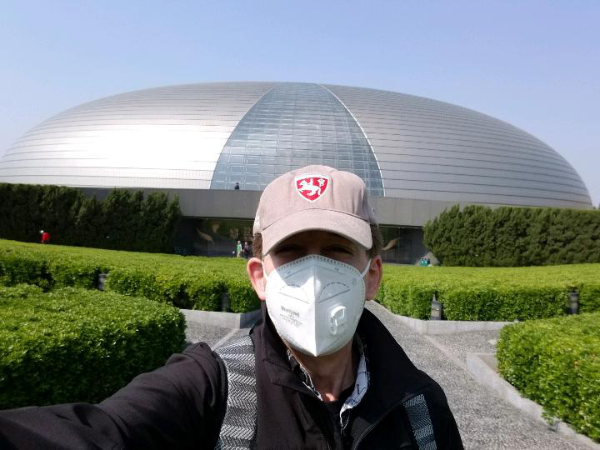
Courtesy of the Cleveland Orchestra
It had been two decades since the Cleveland Orchestra (TCO) visited China.
In late March, the members of the orchestra set out for a three-week tour of Taiwan, Macao and mainland China, including the cities of Shenzhen, Shanghai, Nanjing, Wuhan, and Beijing. Some of the musicians were eager to revisit the same cities they had seen in the 1990s, meet parents of students they taught at the Cleveland Institute of Music, enjoy some great food, and join with colleagues in performing the eleven scheduled concerts. After everyone returned home to Cleveland and had a chance to adjust their biological clocks, I decided to interview four members to gather their personal perspectives of the tour.
Taipei’s National Concert Hall
Photo credit: Richard Weiss
Yun-ting “Win” Lee, one of our youngest members, left Taiwan as a child. Now he had returned as a violinist in TCO to play in Taipei’s National Concert Hall. In talking about this experience, he said, “I was thrilled to play there because it was the same hall where I had heard my very first orchestra concert as a six-year-old child. It was a dream come true.” He was pleasantly surprised to see many enthusiastic Taipei young people in the audience. Since leaving Taiwan, he has occasionally revisited his home country, and feels that over the years the air in Taipei has become cleaner; but not so true of mainland China where on the train from Shanghai to Nanjing, a brown haze could be seen hovering over the countryside.
Feeling that no visit to mainland China would be complete without seeing the Great Wall, Win and some friends planned to go straight there upon arrival at the Beijing airport on their free day. They were amazed that the spot chosen by their guide was devoid of tourists. His group enjoyed spectacular unobstructed views of the sunset.
Richard Weiss, first assistant principal cellist, spent most of his free time giving masterclasses and lessons in Macao, Shenzhen, Shanghai, and Beijing. “At the Shenzhen Arts School, an ensemble of guzheng players entertained our group,” said Weiss. “The guzheng is a traditional Chinese string instrument having 21 strings and 21 moveable bridges. What fun it must be trying to keep them in tune!” In four cities, friends and family of current and former Cleveland Institute of Music cello students gave him tours. Because in Asia it is customary for parents to give gifts to teachers, Weiss needed to purchase a carry-on suitcase to hold all the fine tea and silk scarves he received.
As previously mentioned, air quality is very unhealthy in China, especially in Shanghai and Beijing. Richard observed that while some of the locals wisely wear masks, others apparently fight the smog by chain-smoking! He also noted that the concert halls throughout this tour were visually striking. Taipei’s hall is an example of traditional Chinese architecture, while Beijing’s hall, nicknamed the Giant Egg, is an enormous ellipsoid dome of titanium and glass surrounded by an artificial lake. While enjoying local cuisine, Richard got plenty of practice honing his skills with chopsticks, and learned to write the Chinese characters for xié xié (“thanks”) when leaving a tip for hotel housekeeping staff.

Richard Weiss in front of the Giant Egg
Photo credit: Richard Weiss
Mary Kay Fink, the orchestra’s piccolo player, was also impressed with the outward appearance of Beijing’s concert hall, which she said looks like a spaceship with changing colors of lights at night. Mary Kay was fascinated watching the Chinese youth as they listened in rapt attention to the performances. She had an interesting encounter with a Chinese gentleman who was an attorney. “He wanted to practice his English, so we discussed China’s culture and even some politics,” she said. Since people around them seemed interested in their conversation, the man would stop every so often, look around, and say, “We are being watched.”
While walking through a large public park in Shanghai, Mary Kay came upon a very unusual sight: a marriage market. Apparently, the way this works is that parents post signs containing photo portraits of their young adult children with evidence about their job, car ownership, and housing status in a market-like atmosphere. Other parents stop by, expressing interest and exchanging information. Evidently, amidst the glitz of modern China, there still exist some old Chinese customs.
Michael Sachs, principal trumpet, pointed out that there was a wide range in the acoustics in the various halls in Asia, so in our preconcert acoustic rehearsals, Music Director Franz Welser-Möst asked for slight adjustments in balance and articulation. “Acoustically, the Beijing hall was probably closest to our Severance Hall sound,” commented Michael. For him, the tour was a chance to reconnect with musician friends from the past, and make new friends. Michael noted that students he coached in Taipei and Beijing were eager and showed a strong quest for knowledge; however, he wasn’t certain how much Internet access they might have. He said, “Great strides have been made in the last twenty years with the brass instrument students in China. As Asia develops more brass player role models, it will continue in a positive direction.”
Remembering all the construction cranes he had seen in Shanghai back in the 1990’s, Michael was amazed by the results now. The size, skyline, and scope of the city were completely changed. He also noticed that Shanghai previously had been “a sea of bicycles” with just a few cars, but now was the exact opposite.
This highly acclaimed tour, conducted by Welser-Möst, included works by Beethoven, Tchaikovsky, Prokofiev, and Richard Strauss. Cleverly chosen encores from the Cantonese Suite by Xiaogang Ye and Chinese Galop by Johann Strauss Sr. elicited enthusiastic and unending applause from the audiences.
Note: the author is the principal keyboard player of, and ICSOM delegate for, the Cleveland Orchestra.





